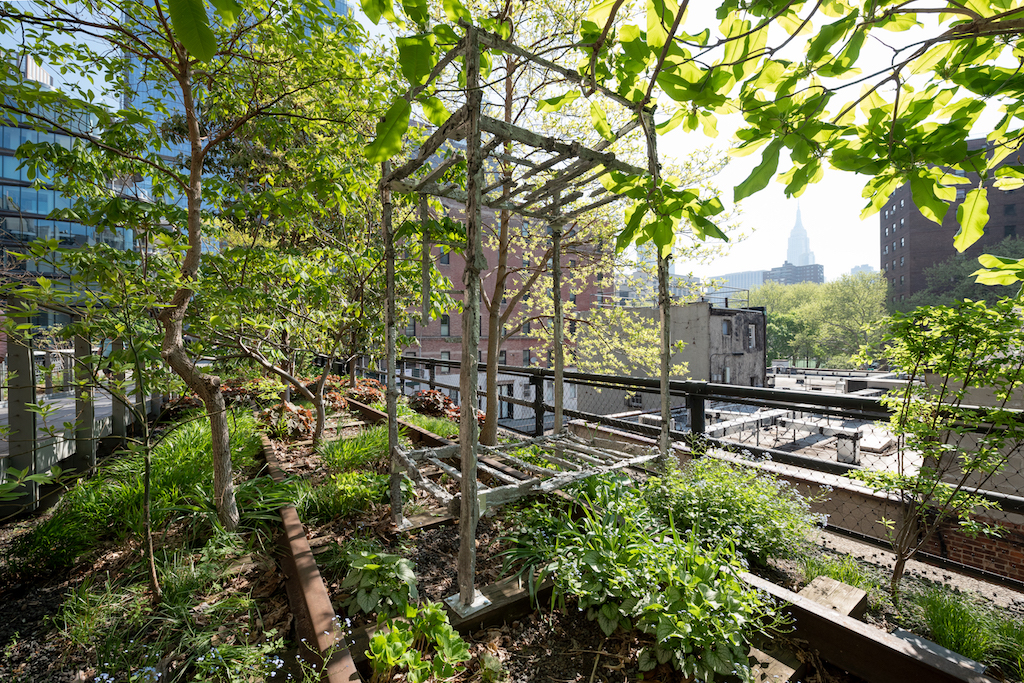[ad_1]

Naufus Ramirez-Figueroa, Void ratio of a bunk bed, 2018.
TIMOTHY SCHENCK/COURTESY HIGH LINE ART
Art abounds on the High Line in New York, where locals and tourists alike stroll the elevated former train track with a mix of bemusement and obliviousness while happening upon work by major artists from all over. “Agora,” a group exhibition that opened in April and runs until March 2019, plays with that mix to consider what Cecilia Alemani, the director and chief curator of High Line Art, called “the public sphere and the role of art and artists in activating public space.”
During a pleasant afternoon perambulation with ARTnews, Alemani said the year-long nature of the exhibition is important: “We really want to capture the changing of the seasons. When we installed in April, there was nothing whatsoever in terms of vegetation—and then it grows and grows even more. The idea is to have a dialogue with the surrounding gardens.”
Below is an edited transcript of a walk through “Agora” with Alemani, starting at the downtown opening of the High Line by the Whitney Museum and ending uptown at 34th Street. —Andy Battaglia
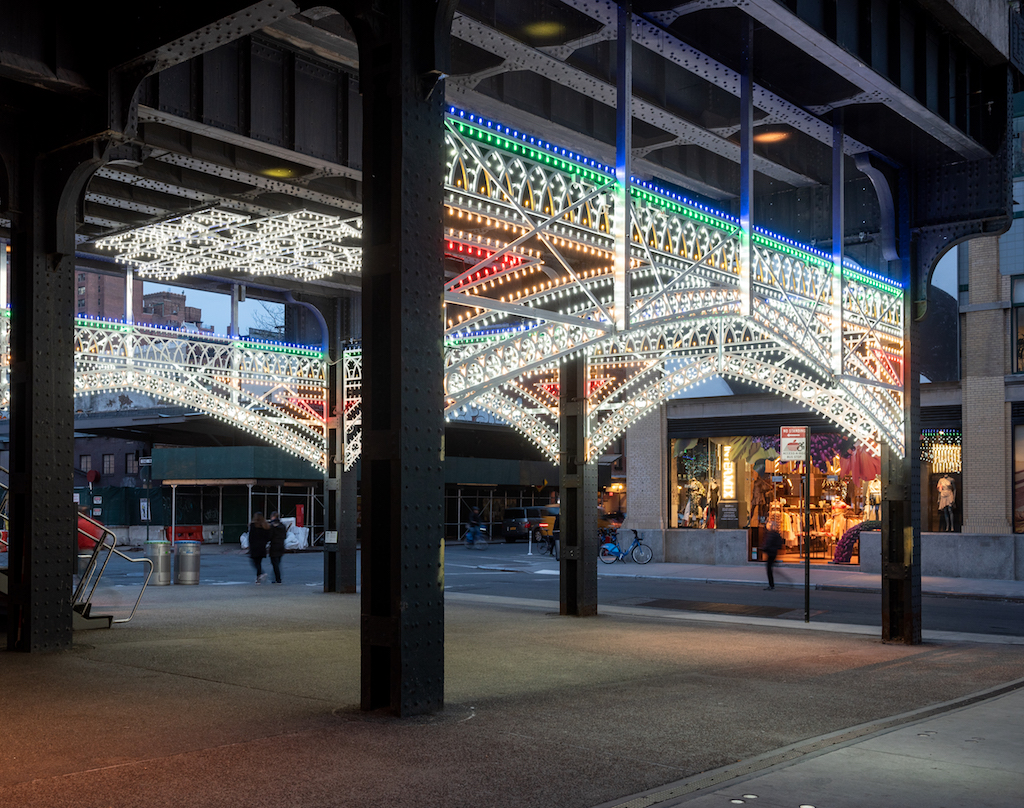
Marinella Senatore, GIVE YOUR DAUGHTERS DIFFICULT NAMES, 2018.
TIMOTHY SCHENCK/COURTESY HIGH LINE ART
Marinella Senatore, GIVE YOUR DAUGHTERS DIFFICULT NAMES
“Marinella Senatore is an artist and activist who works a lot with public procession and gatherings of people. This is a light installation that is reminiscent of a very specific artisan tradition of southern Italy, especially in Puglia, where they make these things called Luminarie, which are basically giant light installations, many for religious festivities, in the summer. They create architecture out of light. At night it’s a feast for the eyes, and it was a way of activating the underside of the High Line, which we don’t use that much. The title comes from a poem that she has always really admired. [The poem is by Waran Shire, who also wrote ‘my name makes you want to tell me the truth. my name doesn’t allow me to trust anyone that cannot pronounce it right.’] This is my seventh season on the High Line and we’ve never had light installations—this year we have four.”
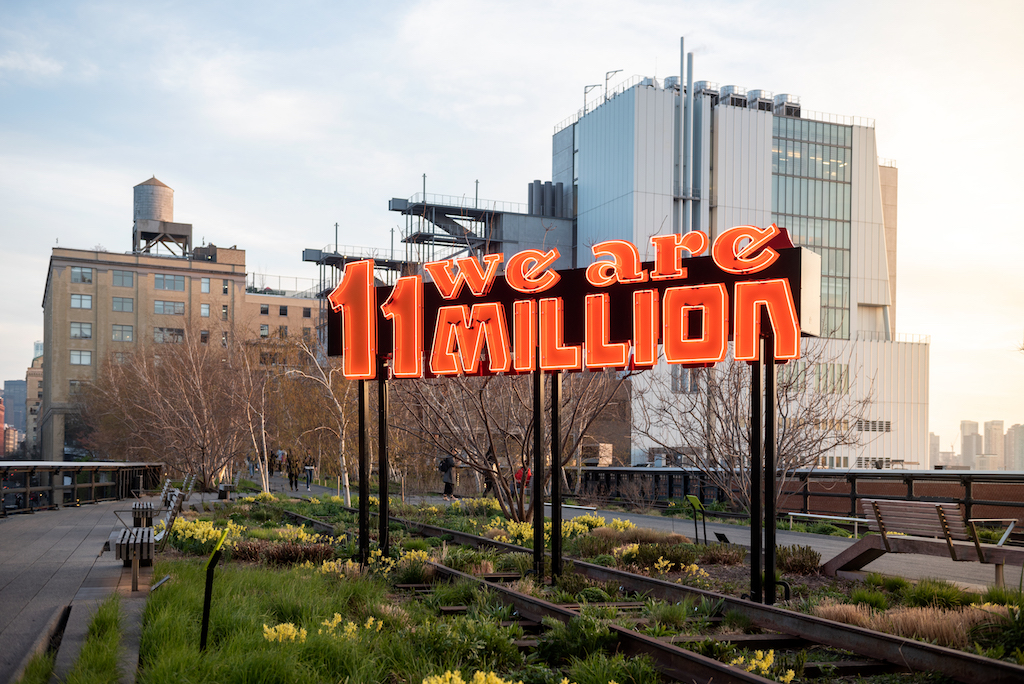
Andrea Bowers, Somos 11 Millones/We Are 11 Million (in collaboration with Movimiento Cosecha), 2018.
TIMOTHY SCHENCK/COURTESY HIGH LINE ART
Andrea Bowers, Somos 11 Millones/We Are 11 Million (in collaboration with Movimiento Cosecha)
“Andrea Bowers often works with tags and slogans, and in the last few years she’s been very into the Dreamers and DACA. In this case she wanted to work with an organization in support of the Dreamers and in support of immigrants to the United States, and to collaborate she asked them to come up with a slogan that then she could transform into an artwork. They came up with this sentence in Spanish—and in English on the other side—that says, ‘We are 11 million,’ which is the number of undocumented immigrants currently in the United States. It’s neon, so at night it’s very, very bright, and she wanted to put it on stilts so it has a monumental and towering presence.”
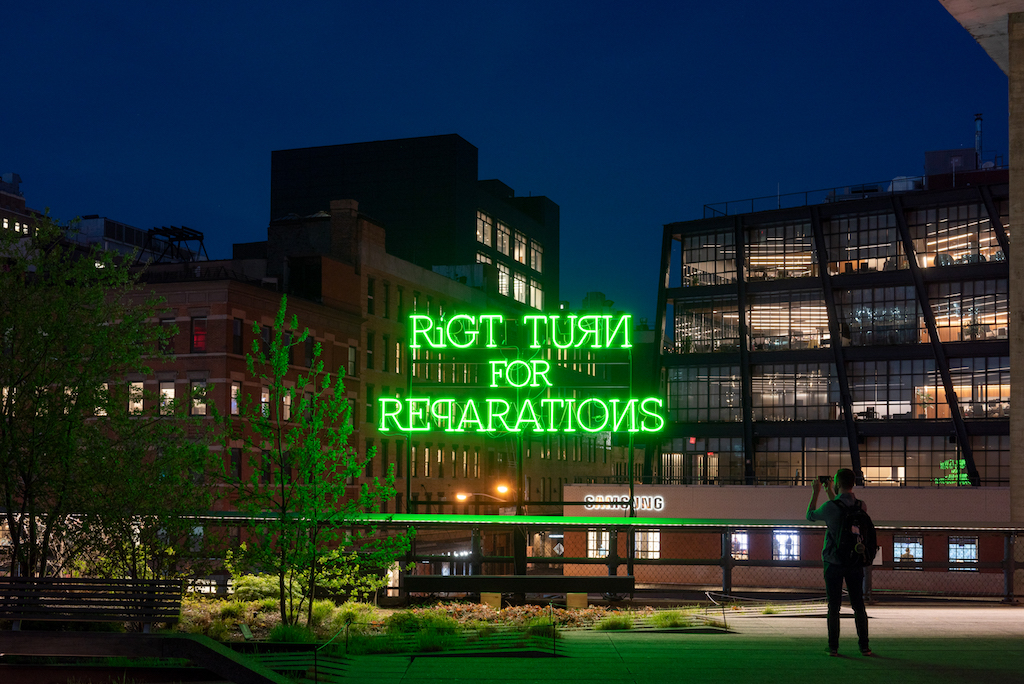
Pope.L, chmera, 2018.
TIMOTHY SCHENCK/COURTESY HIGH LINE ART
Pope.L, chmera
“This is a new piece by Pope.L that spells out ‘Right Turn for Reparations.’ It’s green on one side and red on the other—he wanted to evoke street lights but there is also the Pan-African flag with the black, the green, and the red. He picked this location because it was very important for him that, on the street level or driving by, you could actually make a right turn—it’s not easy to find a street where you can do that [owing to one-way streets in the area]. It’s positioned kind of off the grid because it was important to be visible from the street. The title is misspelled on purpose, and the ‘P’ in reparations is upside-down. He’s a lovely artist to work with.”
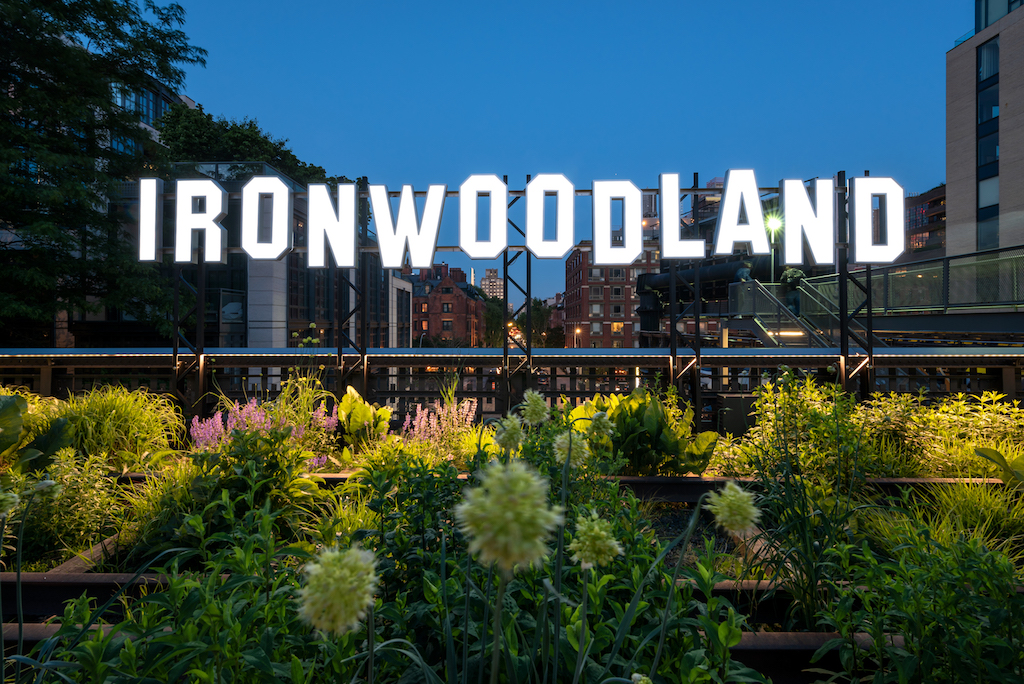
Sable Elyse Smith, C.R.E.A.M., 2018.
TIMOTHY SCHENCK/COURTESY HIGH LINE ART
Sable Elyse Smith, C.R.E.A.M.
“Sable Elyse Smith was interested in creating this landmark to conflate two main aspects of the Hollywood sign, with typography that copies by that. The Hollywood sign used to say ‘Hollywoodland’ when it was built in the 1920s—not many people know that—and it was an advertisement for a segregated real-estate development that was being built around the Hills. When the ‘land’ dropped off it became this iconic symbol of L.A., but it has a shady past. And then, Ironwood is the name of the state prison where Smith’s father has been incarcerated for many years. She spent her youth going to visit him. There’s also a kind of a resonance because on 20th Street there used to be the women’s prison. It’s still there—but no longer a prison.”

Mariechen Danz, The Dig of No Body (soil sample), 2011/2018.
TIMOTHY SCHENCK/COURTESY HIGH LINE ART
Mariechen Danz, The Dig of No Body (soil sample)
“Mariechen Danz, an Irish-born, Berlin-based artist, was part of the Venice Biennale last year, and she often looks at the human body as a repository of knowledge. In this case she’s alluding to anatomical models that you use to learn about anatomy that have trays with different organs, but she’s also using very creative materials—gold, aluminum, wood, semi-precious stone, sand, garbage, shells. She calls it The Dig of No Body (soil sample)—it’s almost like a geological dig but also kind of an assemblage of different materials used in sculpture.”
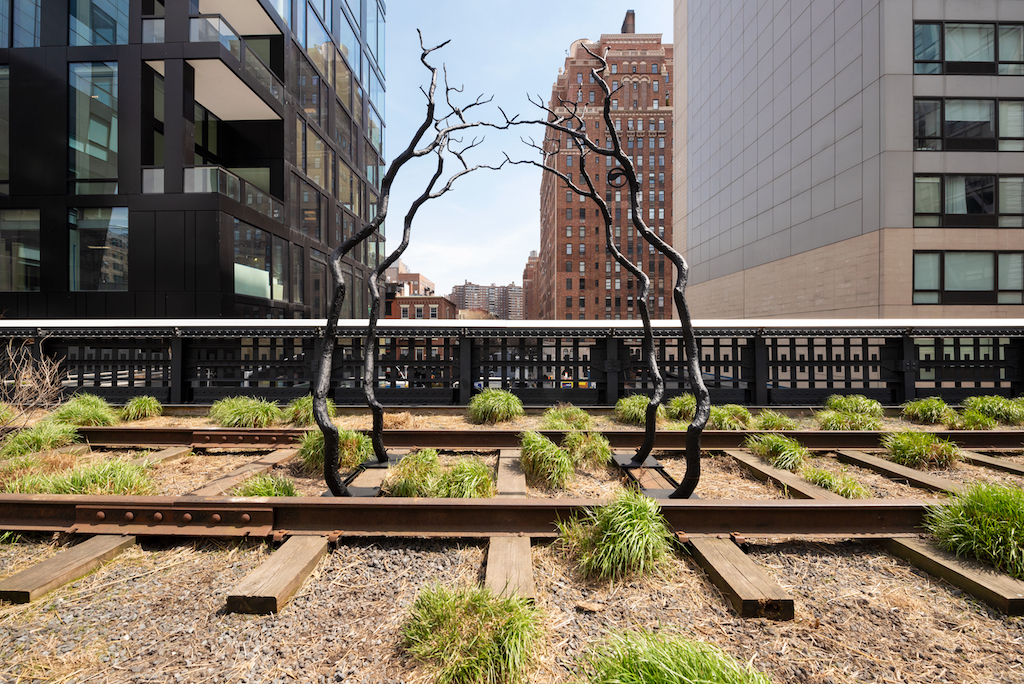
Timur Si-Qin, Forgiving Change, 2018.
TIMOTHY SCHENCK/COURTESY HIGH LINE ART
Timur Si-Qin, Forgiving Change
“Timur Si-Qin has been interested in looking at the interaction between technology and the environment. In this case, he wanted to do something about the wildfires in California last year, so he went out and scanned a burnt tree and then replicated it four times. It’s basically casts made in aluminum and then painted made with this very dark. It’s like modern sequel to something natural. When you see it from the street it looks almost like a chapel or a little altar, but then you realize that it’s burnt wood.”

Naufus Ramirez-Figueroa, Void ratio of a bunk bed, 2018.
TIMOTHY SCHENCK/COURTESY HIGH LINE ART
Naufus Ramírez-Figueroa, Void Ratio of a bunk bed
“Naufus Ramírez-Figueroa is an artist from Guatemala who has a show at the New Museum. His work is about connecting personal memories and the story of his own country, and this is . . . I’m laughing because, when we installed it, there was not even a leaf and now it’s completely surrounded. But it’s a cast of a bunk-bed made in aluminum, and he wanted to evoke the fragility of childhood but also a less-known history. Apparently during the military dictatorship in Guatemala, from the ’60s to the ’90s, there were lots of illegal orphanages that became a theater of shady and illegal activities, so he wanted to evoke that with this unstable construction. We chose this location because we knew that it would get covered by the leaves. It’s almost like protecting and offering shelter. When he was here we saw a nest of a bird, and he said, ‘Please don’t remove it—I love it.’ Again, going back to the idea that everything changes with the seasons, when we installed it for a couple of months you could see it very well, and then in the summer it gets covered up but then in October it’s going to reappear.”
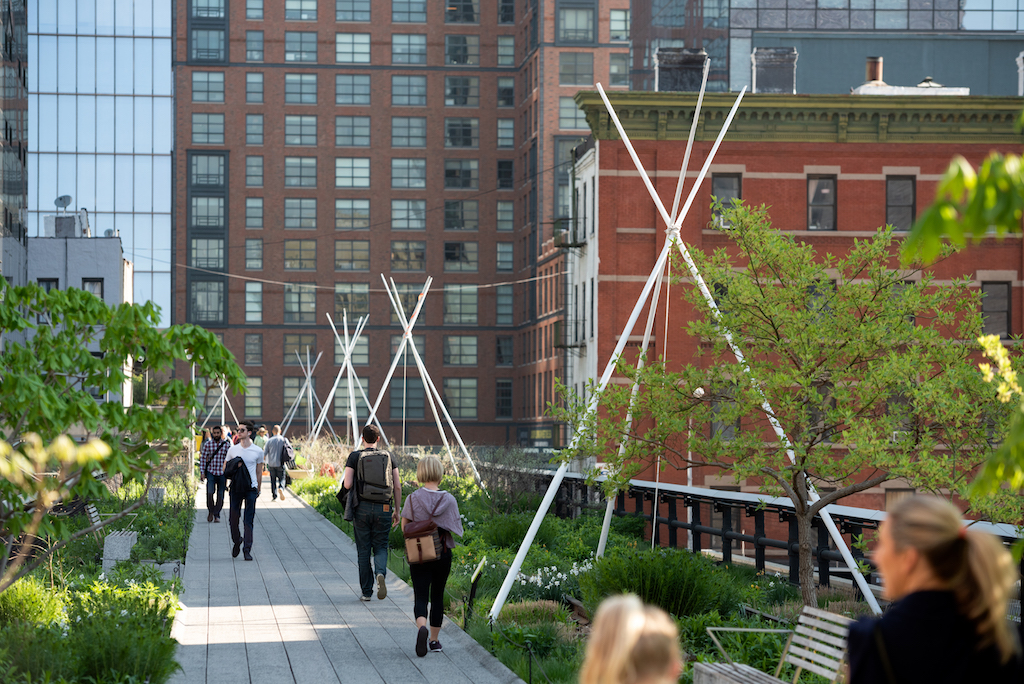
Duane Linklater, pêyakotênaw, 2018.
TIMOTHY SCHENCK/COURTESY HIGH LINE ART
Duane Linklater, pêyakotênaw
“These five large sculptures are by Duane Linklater, who’s a Moose Cree First Nation artist from Ontario, Canada. He usually looks at the ways Western institutions organize and name Native American artifacts and artworks, and for the High Line he wanted to create a juxtaposition with the bombardment of the new buildings and real estate by bringing in a much more nomadic and temporary form of dwelling: the teepee. Each teepee is grounded down by a giant boulder. He’s created these very familiar shapes and bringing a natural element inside, but the main reference is to bring a spontaneous form of housing. And he loved the idea of being in front of Zaha Hadid [whose undulating building at 520 West 28th Street looms nearby].
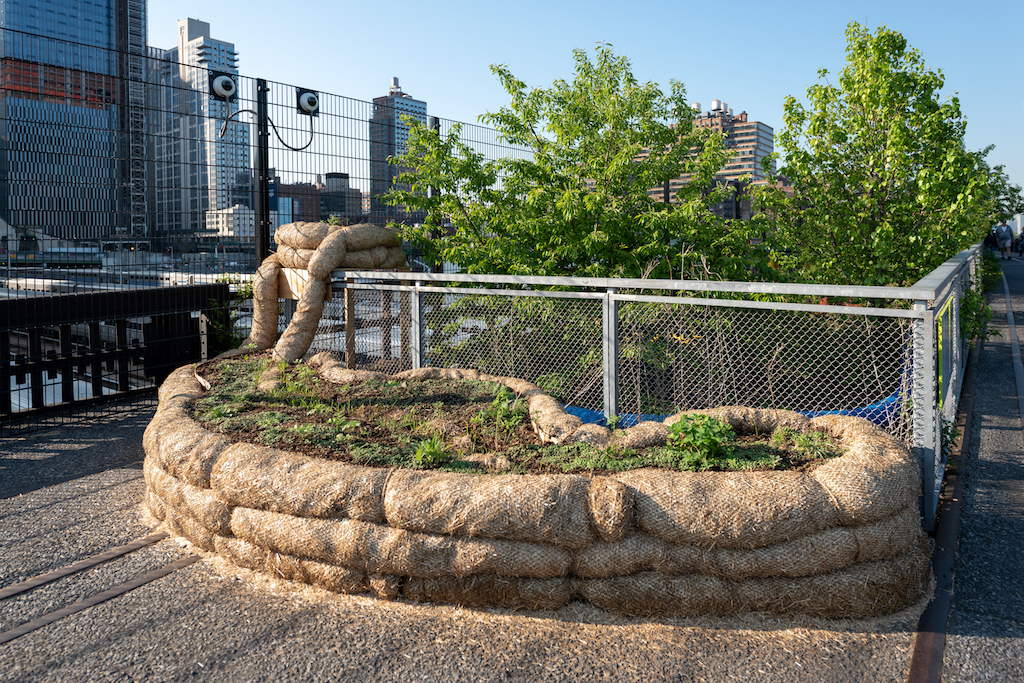
Maria Thereza Alves, A Ballast Flora Garden: High Line, 2018.
TIMOTHY SCHENCK/COURTESY HIGH LINE ART
Maria Thereza Alves, A Ballast Flora Garden: High Line
“Maria Thereza Alves, a Brazilian artist who lives in Berlin, and for many years she had been doing this work called Seeds of Change. She follows seeds’ migration due to man, not to nature, and she’s been doing a lot of studies in harbor cities like Bristol, England, and also New York, studying what’s called the ballast flora, which are dormant seeds that were brought with cargo ships from the 1700s onwards. Ballast was used as counterweight for the boats, and at the port they would dump it—mainly dirt or bricks or soil—in the harbor. But the ballast was actually carrying seeds, and so many of the seeds that find here and on the High Line that we call native are actually not native of the United States at all—they come from West Africa or the U.K. or the Netherlands. Alves got the award from the Vera List Center for Arts and Politics two years ago, and so this is a collaboration with the Vera List Center and Pioneer Works and Weeksville Heritage Center. We all have a garden made of these seeds, which we consider native to New York City though they’re not native at all. She questions the notion of migration and what it means to be native.”
[ad_2]
Source link
Warning: Undefined variable $post in /var/www/wp-content/themes/newsup/inc/ansar/hooks/hook-index-main.php on line 117

